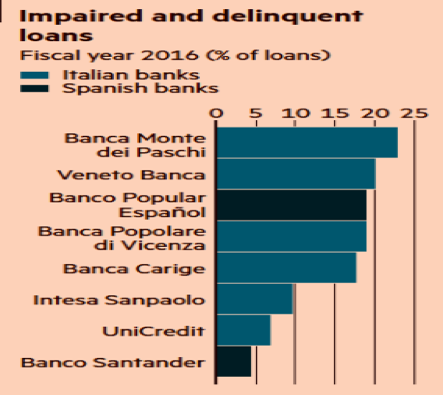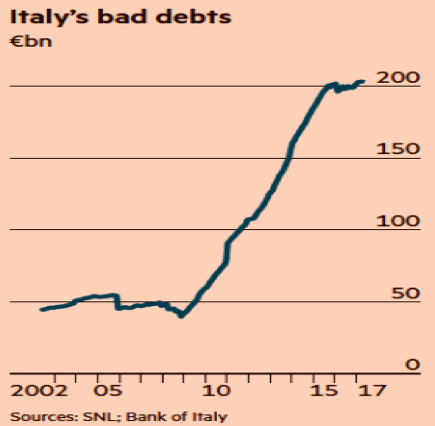In the last few weeks two developments – related to key issues for the health of the global economy – have been unfolding. The first deals with European banks, and the second with the trajectory of oil prices. Last month two major Spanish banks (Santander and Intensa Sanpaolo) were allowed to buy out failing rivals for €1. Shareholders were wiped out and junior bondholders lost their investments, while senior bondholders and depositors were protected. Of course, such arrangements contradicted the resolution arrangement agreed upon almost two years ago, in which the EU authorities showed some determination to avoid bailouts at taxpayers’ expense. The theatrics of the EU played out again last weekend, when EU authorities allowed the Italian government to bail out two failing banks (Veneto Banca and Banca Popolare di Vicenza) by injecting €17 billion into them.
The abolition of the rules may bring into question the institutional authority which the EU was hoping to establish as a serious endeavor where rules simply rule, ignoring the politics and the mentality of advancing regional clientele’s vested interests by violating the rules of meritocracy and thus undermining growth prospects. We have been arguing for years that the EU’s banking sector is facing serious problems (non-performing loans/NPLs, overvalued assets, collateral holes, derivatives exposure, and so on) that could eventually lead to a global financial implosion, especially when combined with Chinese financial tremors due to a debt hangover and inability to meet obligations.
The graphs below show a fraction of the NPLs in Italy and Spain. The size of the NPLs as well as the magnitude of their share as a percentage of total loans is also reflected in the ECB’s latest announcement on Monday that the extraordinary accommodative and expansionary monetary policy will continue.


Certainly the ECB’s excuse that deflationary forces may still be at work (in order to justify the loose policy) should be interpreted as a statement that the fragile banking sector is unable to normalize credit conditions and therefore the EU-wide economy is susceptible to tremors and recessionary forces. There may be some merit to the arguments of the Italian government that if the resolution mechanism had been applied, then a domino effect would have happened that could have undermined the whole Italian banking sector. However, that also shows the fragility of the EU-wide financial institutions, because a collapse of the Italian banking system would very likely have affected French, German, British and all other banks in the EU.
The economies-wide fragility may also be partially reflected in yesterday’s projection by the IMF that the US growth rate will be lower than originally thought. To this we should also add that the recent declines in oil prices are primarily the result of supply forces; however, a slowing demand and a slower growth rate in the US may further reduce oil prices – or keep them down – which in turn will affect credit conditions and especially high yield bonds, given that a good percentage of them concentrate in the oil sector.
EU’s recovery is critical for global growth at a time when US leadership is questioned and especially when US developments may point to a slower growth. If EU recovery is jeopardized at a time when oil prices are in bear territory and the US growth rate slows down, then the deterioration of credit conditions will have negative effects on both equity and bond markets in the medium term.
